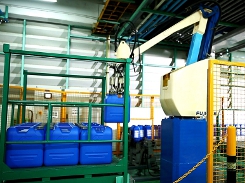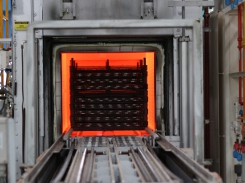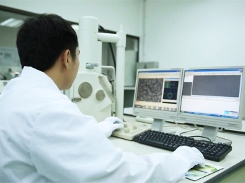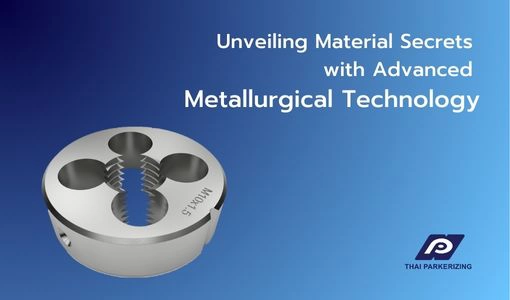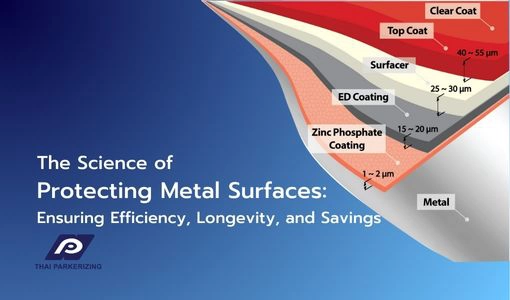- Corporate
- Chemical Products
- Chemical Controller
- Chemical for Paint Booth
- Coil Coating
- Degreasing and Cleaning chemical
- Heat&Cool exchanger (PLATECOIL)
- Hydrophilic
- Manganese Phosphate
- Nano-coating (Pallucid)
- Rolling Oil
- Rust Preventive Product
- Stearate Soap Lubricant/Dry-in-Place Lubricant (PULS)
- Trivalent Chromium/Non-Chromium
- Zinc Phosphate/Iron Phosphate
- Processing Services
- Laboratory Services
- Articles
- What's New
- Contact Us
- Privacy Policy
Unlocking Industrial Insight: The Importance of Chemical Analysis in Modern Manufacturing
10 June 2025
In an increasingly competitive and quality-driven industrial landscape, chemical analysis is no longer optional, it is essential. Whether you're in metal treatment, surface finishing, wastewater management, or high-precision manufacturing, understanding the chemical composition of your materials, solutions, and byproducts is the key to performance, safety, compliance, and cost control.
At Thai Parkerizing Co., Ltd, we employ a full suite of advanced analytical techniques to help clients maintain the highest quality standards. Our in-house testing capabilities are designed to not only troubleshoot production issues but to also provide predictive insight, allowing you to optimize your processes before problems arise.
Lets look at some of the cornerstone instruments we use in our chemical analysis lab, and how each plays a vital role in driving manufacturing success.
Key Instruments used in Industrial & Manufacturing Chemical Analysis

Ion Chromatography (IC): Targeting Trace Ions with Surgical Precision
Purpose: Detects and quantifies ionic species such as Fluoride, Chloride, Nitrate, Sulfate, and Phosphate in complex matrices.
Why It Matters: Even parts-per-million (ppm) levels of ionic contamination can severely impact corrosion resistance, electroplating quality, and water treatment performance. IC ensures that your bath formulations and rinse water remain within specification
Real-World Example:
In a surface treatment process for aluminum components, unexpected corrosion was observed. Ion Chromatography revealed elevated chloride levels in the rinse stage, traced back to a faulty filtration unit. With that knowledge, the customer is able to correct the issue, greatly reducing corrosion defects.
Total Organic Carbon Analyzer (TOC): Tracking Hidden Organic Load
Purpose: Measures the total amount of organic carbon in liquids, a critical parameter in assessing cleanliness and environmental discharge quality.
Why It Matters: Organic contamination, often invisible to the eye, can interfere with coating adhesion, fuel system efficiency, and even wastewater permits. TOC analysis gives a quick snapshot of contamination levels.
Real-World Example:
A manufacturer of automotive fasteners experienced sporadic adhesion issues with phosphate coatings. TOC analysis of the degreasing bath revealed a gradual buildup of residual cutting oils. The tank change schedule was revised based on TOC data, resulting in far fewer rejected batches.
Fourier Transform Infrared Spectrophotometer (FTIR): The Fingerprint of Molecules
Purpose: Identifies organic compounds by detecting characteristic molecular vibrations, each material has a unique IR "fingerprint."
Why It Matters: When facing unknown contamination or product inconsistencies, FTIR can identify residual films, additives, or unexpected chemical changes fast.
Real-World Example:
A heat treatment client noticed discoloration on treated parts. FTIR analysis of surface residues identified degraded quenching oil components. This led to a revised maintenance protocol and new filtration system, preserving product integrity and customer confidence.
Inductively Coupled Plasma Optical Emission Spectroscopy (ICP-OES): Elemental Analysis at Its Finest
Purpose: Quantifies trace metals and elements down to sub-ppm levels across a broad spectrum.
Why It Matters: Precise control of metallic ions—such as iron, nickel, manganese, and zinc—is essential in electroplating, passivation, and chemical baths. ICP-OES provides fast, accurate readings for complex solutions.
Real-World Example:
In a zinc-phosphating line, inconsistent coating weight prompted analysis. ICP-OES revealed variations in manganese concentration caused by raw material inconsistency. Adjustments were made to normalize bath chemistry, stabilizing the process and significantly reducing coating failures.
UV-Vis Spectrometer: Simple, Fast, and Highly Versatile
Purpose: Measures light absorbance to determine the concentration of colored or UV-absorbing compounds.
Why It Matters: Ideal for routine monitoring of known species such as iron (Fe2+/Fe3+), chromate, copper, or dyes—allowing quick checks for process control or contamination.
Real-World Example:
A client needed to monitor hexavalent chromium levels in their wastewater before discharge. UV-Vis offered a fast, cost-effective solution that allowed real-time decision-making and ensured regulatory compliance without expensive delays.
In heat treatment operations, quenching oil plays a central role in achieving the desired mechanical properties of metal components. Whether you're hardening gears, shafts, or tools, the quality of the quenching oil directly affects hardness, surface finish, distortion, and part longevity.
However, many operations run into inconsistent results due to undetected oil degradation or improper maintenance. That’s where Quenching Oil Analysis becomes essential.
Below are the key testing tools we use to analyze the condition, stability, and cooling characteristics of quenching oils.
Key Instruments used in Quenching Oil Analysis

Kinematic Viscosity: Measuring Flow and Film Strength
Purpose: Determines the oil’s resistance to flow under gravity, measured in centistokes (cSt) at standardized temperatures.
Why It Matters: Viscosity affects the oil’s ability to form a consistent film around the part and impacts its cooling speed. Over time, thermal breakdown or contamination can cause viscosity drift.
Real-World Example:
A tool steel manufacturer experienced uneven hardness and distortion in high-speed components. Kinematic viscosity testing revealed an increase in oil thickness due to oxidation and sludge buildup. An oil change and filtration upgrade restored proper flow and quenching consistency.
Flash Point: Safety and Stability Benchmark
Purpose: Identifies the temperature at which oil vapors ignite when exposed to an ignition source.
Why It Matters: A reduced flash point indicates the presence of volatile degradation products or contamination—posing fire risks and operational instability.
Real-World Example:
Routine analysis of a batch quenching line showed a considerable drop in flash point. Investigation confirmed contamination by low-boiling-point cutting fluids. Removing the contaminated batch and adjusting upstream processes improved workplace safety and oil performance.
Coulometric Karl Fischer: Accurate Moisture Detection
Purpose: Measures the exact moisture content in oil with high sensitivity, typically in parts per million (ppm).
Why It Matters: Water contamination can cause violent reactions during quenching, such as foaming, cracking, or vapor explosions. Even small amounts can affect cooling curves and part integrity.
Real-World Example:
A hardened bearing supplier suffered surface cracking issues. Karl Fischer testing revealed abnormal moisture levels in the oil, caused by ambient humidity ingress during open-tank downtime. A new sealing and preheat system was implemented, reducing defect rates significantly.
Carbon Residue: Evaluating Oxidative Breakdown
Purpose: Determines the percentage of carbon left behind after oil is heated in the absence of oxygen.
Why It Matters: A higher carbon residue indicates significant thermal degradation, leading to sludge, varnish, and blocked filtration systems—compromising heat transfer.
Real-World Example:
A client saw increasing downtime due to clogged lines and filters. Carbon residue analysis showed an increase in deposit-forming potential. Transitioning to a higher thermal stability oil and regular sampling prevented buildup and saved tens of man hours of yearly maintenance.
Total Acid Value (TAV): Gauging Oxidation and Degradation
Purpose: Measures the acidity in oil caused by oxidation products and degradation.
Why It Matters: As oil degrades, acidic compounds form, accelerating corrosion and destabilizing additives. Monitoring TAV helps predict end-of-life.
Real-World Example:
In a continuous quenching system, increased rusting of parts raised concern. TAV testing showed values double the safe operating limit, indicating oil was chemically exhausted. A planned changeout was made, eliminating rust complaints and extending the maintenance interval.
Cooling Characteristic: The Heart of Heat Treatment Performance
Purpose: Analyzes how oil cools a standard heated probe—typically using a device like the Quenchotest or GM Quenchometer. Cooling rate vs. temperature is plotted as a curve.
Why It Matters: The entire purpose of quenching oil is to control heat extraction. If the oil's cooling behavior changes, metallurgical results shift—leading to under- or over-hardening, distortion, or internal stress.
Real-World Example:
An aerospace part supplier detected inconsistent hardness depth in large components. Cooling curve analysis showed a loss of peak cooling rate and delayed vapor phase breakdown. A chemical rebalancing of the oil, combined with agitation adjustment, brought performance back to spec.
Chemical Intelligence That Drives Decisions
Our investment in high-precision analytical tools reflects our commitment to performance, safety, and sustainability. Whether you are investigating a production issue, optimizing a chemical bath, or ensuring environmental compliance, our expert lab team and comprehensive testing capabilities provide you with the data to act decisively and confidently.


